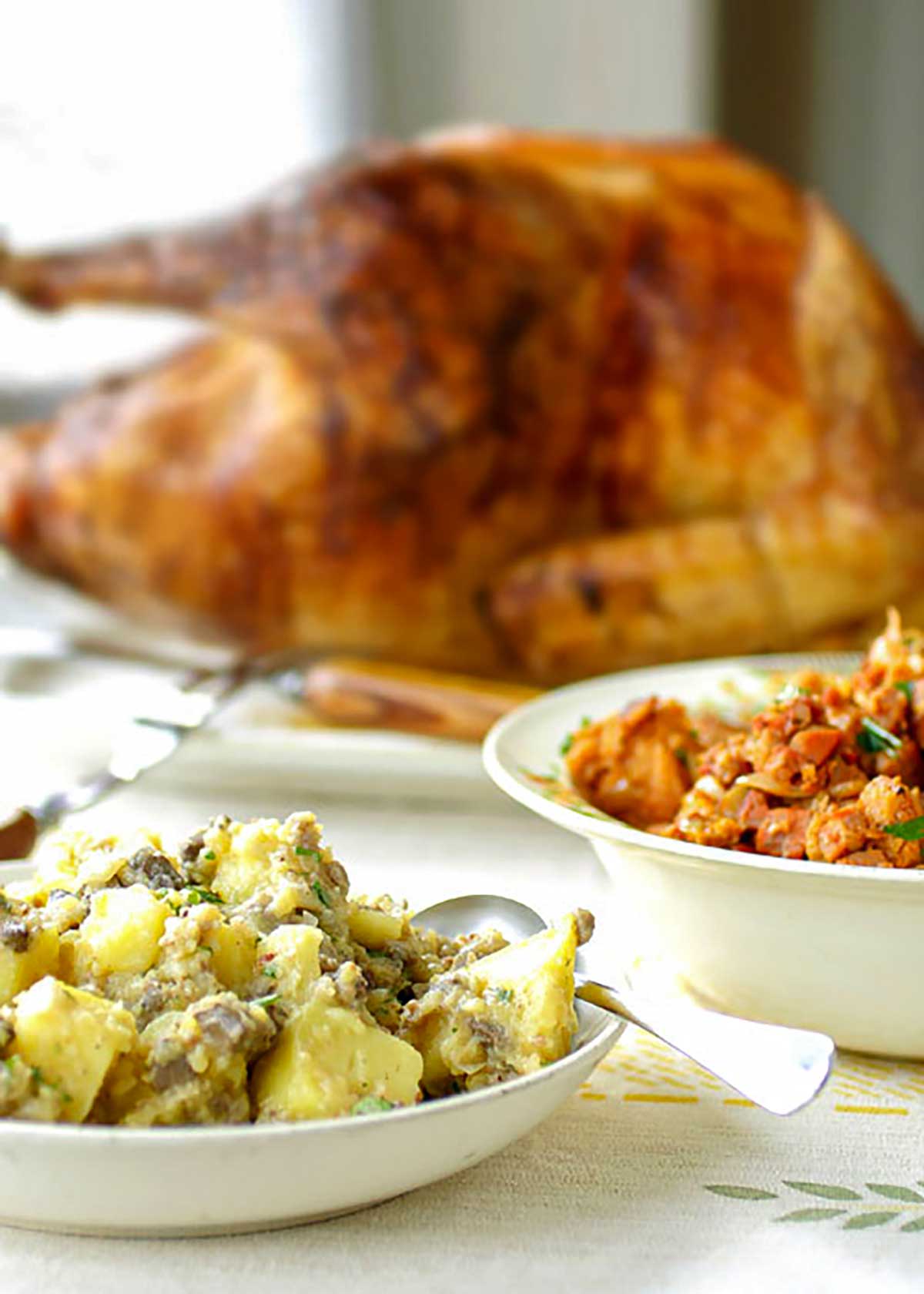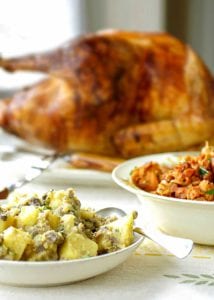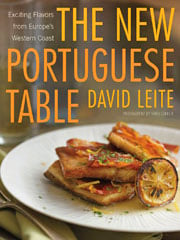
This is the same paprika-sprinkled Portuguese turkey that I grew up with. My grandmother Costa always rubbed her poultry with salt and let it sit in the fridge for several hours prior to roasting, believing that it drew out impurities. Her ritual is similar to the koshering process, in which poultry is coated with salt and later rinsed several times. The benefit—voodoo aside—is a bird that’s juicy and richly flavorful. That’s why I insist you buy a kosher turkey. And I’m offering you a couple different Portuguese stuffings. Because one is never enough.–David Leite
☞ READ THE ARTICLE: A TALE OF TWO PORTUGUESE STUFFINGS ☜

Portuguese Turkey with Two Stuffings
Equipment
- Kitchen string
Ingredients
For the turkey
- One (12- to 14-pound) kosher turkey, liver reserved for the dressing
- 1 small orange, cut into wedges
- 1 small lemon, cut into wedges
- Kosher salt and freshly ground black pepper
- 4 Turkish bay leaves
- 6 tablespoons unsalted butter, melted
- 2 teaspoons sweet paprika
For Dina’s potato stuffing
- 1 1/2 pounds Yukon Gold potatoes, peeled and cut into 1‑inch cubes
- Kosher salt
- 2 tablespoons unsalted butter, plus more if needed
- 3/4 pound ground sweet Italian pork sausage
- 1 large yellow onion, chopped
- 2 garlic cloves, minced
- Reserved turkey liver, chopped
- 2 large egg yolks, beaten
- 1/2 cup whole milk, plus more if needed
- Healthy pinch ground nutmeg
- 2 tablespoons chopped flat-leaf parsley leaves
- Freshly ground black pepper
For Avó Costa’s bread stuffing
- 1/4 pound thick-sliced slab bacon, cut crosswise into 1/4-inch pieces
- 1 pound chouriço, linguica, or dry-cured smoked Spanish chorizo, roughly chopped
- Olive oil, if needed
- 2 medium yellow onions, chopped
- 4 garlic cloves, minced
- 1/4 teaspoon crushed red pepper flakes
- 2/3 cup dry white wine
- 3 tablespoons Amped-Up Red Pepper Paste
- 2 tablespoons double-concentrate tomato paste, or three tablespoons regular store-bought or homemade tomato paste
- 12 cups 3/4-inch (18-mm) cubes of day-old rustic bread
- About 2 cups homemade beef stock plus 1 cup water or 3 cups store-bought low-sodium broth
- Kosher salt and freshly ground black pepper
- 1/4 cup chopped flat-leaf parsley leaves
For the gravy (optional, seeing as it’s not the Portuguese way, but so worthwhile)
- Up to 3 cups homemade chicken stock or low-sodium chicken broth
- 1/4 cup unsalted butter, at room temperature
- 1/4 cup all-purpose flour
- Kosher salt and freshly ground black pepper
Instructions
Roast the turkey
- Position a rack in the bottom of the oven and crank up the heat to 425°F (218°C).
- Pat the turkey dry with paper towels. Rub the inside of the cavity with the cut side of 1 wedge of orange and 1 wedge of lemon and then toss them in the cavity. Generously season the cavity with salt and pepper and then stuff it with the remaining wedges and the bay leaves. Tuck the wing tips beneath the bird, as if it were folding its arms behind its head, and tie the legs together with kitchen string.
- In a small bowl, mix together the melted butter, paprika, 1 1/2 teaspoons salt, and 1 teaspoon pepper. Brush about half of the butter mixture over the turkey. Place the bird, breast side down, on a V-rack set in a roasting pan.
- Slip the turkey into the oven, pour 2 cups of water into the pan, and roast for 30 minutes. Reduce the heat to 350°F (176°C), flip the bird breast side up, and brush with some of the remaining butter mixture.
- Continue roasting the turkey, brushing it every 30 minutes with the butter mixture, until an instant-read thermometer inserted into the thickest part of the thigh registers 165°F (74°C), 1 1/2 to 2 hours more. Tent the bird with foil if it’s browning too quickly.
- Transfer the turkey to a serving platter and let stand, tented, for 20 minutes. Although it’s not the custom in Portugal, you can make gravy.
Make Dina’s potato stuffing
- While the turkey roasts, toss the potatoes in a large pot of cold water. Add 1 tablespoon salt, cover, and bring to a boil over high heat. Cook until tender, 10 to 15 minutes. Drain the potatoes, return half of them to the pot, and mash well with a handheld masher or a fork. Set the rest of the potatoes aside and cover to keep warm.
- In a medium skillet over medium-high heat, warm the butter until it melts and the foaming subsides. Crumble in the ground sausage and cook, breaking up the clumps, until well browned, 10 to 12 minutes.
- Using a slotted spoon, scoop the sausage into the pot with the mashed potatoes and set that aside for the moment. Reduce the heat under the skillet to medium and, if the skillet seems dry, add a little more butter. Add the onion and cook, stirring occasionally, until golden, about 12 minutes. Stir in the garlic and cook, stirring, for 1 minute more. Add the chopped reserved liver and cook, stirring, until browned, about 3 minutes more. Scoop the mixture into the pot with the mashed potatoes.
- Whisk the yolks and milk into the potato mixture until smooth; if the dressing seems too thick, whisk in more milk. Place the pot over medium heat and stir until the yolks are cooked, about 3 minutes. Fold in the reserved potatoes, sprinkle in the nutmeg and parsley, and season well with salt and pepper to taste. Keep warm.
Make Avó Costa’s bread stuffing
- While the turkey roasts, warm a Dutch oven over medium-low heat. Add the bacon and cook, stirring often, until the bacon is crisp and the fat has rendered, 12 to 15 minutes.
- Using a slotted spoon, transfer the bacon to paper towels. Pour off all but a thin film of fat from the pot into a cup. Bump up the heat to medium-high, add the chourico, and cook, stirring often, until lightly browned, about 7 minutes. Using a slotted spoon, transfer the sausage to a bowl. Pour off all but 2 tablespoons of fat, adding it to the bacon fat. If the Dutch oven seems dry, add 2 tablespoons of oil.
- Lower the heat to medium, add the onions, and cook until softened, 7 to 10 minutes. Add the garlic and pepper flakes and cook for 1 minute more. Splash in the wine, add the red pepper paste and tomato paste, and stir to scrape up any stuck-on bits. Then let everything burble for a few minutes to cook the mixture.
- Turn the heat to low, add the bread and the reserved bacon and chourico fats, and pour in just enough of the stock-water combination, beating well with a spoon, to make the mixture moist. If you use all the liquid and the pot is still dry, add water as necessary. Fold in the bacon and chourico and continue beating to lighten the mixture. Take a taste and season with salt and pepper if needed. Scoop the dressing into a bowl and sprinkle with the parsley.
Make the gravy (not traditional but knock yourself out if you’d like!)
- Spoon off and discard the fat from the surface of the juices in the roasting pan. Place the pan over 2 burners and add enough homemade chicken stock or store-bought low-sodium broth to the juices in the pan to equal 3 cups. Bring the liquid to a boil over medium-high heat, scraping the bottom to loosen any browned bits.
- In a small bowl, blend together the butter and flour until a smooth paste forms. Whisking constantly, slowly add the paste to the liquid in the roasting pan and whisk until the gravy thickens and no floury taste remains, 5 to 10 minutes. Strain and season with salt and pepper to taste.
Serve the turkey and dressing(s)
- When you're ready to sit down to dinner, plate the turkey, scoop the dressings into decorative bowls, and take everything to the table pronto.
Video

Nutrition
Nutrition information is automatically calculated, so should only be used as an approximation.










Hi, David! My ávo was born in Waialua, Oahu, Hawaii in 1884. She did this for all her children at all holidays. She had five boys and three girls. Three did not make it. I’m going pass on the Portuguese stuffing recipe.
(John also shared with me his gloriously gorgeous turkey. A little Thanksgiving trivia: John’s last name, “Peru,” means turkey in Portuguese.–David)
John, thank you for both the stuffing recipe and the picture of the bird. They look wonderful.
I hope this encourages more people of Portuguese descent to send in their Thanksgiving (and Christmas!) stuffing recipes.
Hi! David, thanks so much.. You just don’t know how I’m thankful. My ávo was Mrs. Philpmena C. Cazinha. She was the Best. It’s her and my mom, Mrs. Madeline C. Peru, that I got to cook. They never said a bad word about cooking, they just knew what to cook and just cooked their hearts out. Every Day. She did so much that’s my mom they all called her Aunty Lana…short for Madeline.
So thank you, David.
John M. Peru: They called me, Johnny Boy!
My pleasure. Thank YOU, John. I mean Johnny Boy.
David,
This is all too familiar (both in the similar and familial sense) to what used to happen during Christmas Eve dinners of yore with my mother’s extended family. Mum is one of 10 siblings; we are 16 cousins. There was always much shouted conversation, happy confusion and general mayhem with up to 40 people at these dinners. The siblings would take turns every year to host the dinners, but everyone brought something to the table (the table would be two or three lined up end to end) … including three different stuffings/dressings from two sisters (Mum being one of the two) and a brother – all fiercely proud cooks. “Girl, have you had my stuffing yet?” would be the annual inevitable question from Aunt Maureen – whose stuffing was a Chinese riff on chestnut, sausage and mushroom – Chinese preserved sausage (lap cheong), dried shiitake mushrooms, chestnuts, rice wine, soy sauce.
God help me, I could never swallow more than one spoon of Aunt Maureen’s stuffing.
It was a context thing for me – this is CHRISTMAS EVE DINNER for goodness’ sake – not CHINESE NEW YEAR’S EVE DINNER. Her stuffing would have been great encased in seasoned glutinous rice, wrapped up in lotus leaves, and steamed until plump and fragrant. All I heard and tasted were discordant and vaguely disturbing culinary notes… I’d end up hiding the leftovers in a scrunched-up paper napkin. But that wasn’t the end of it – she’d have little foil packets of the stuffing for every family to take back home, without fail. Of course in the days that followed, Mum would reinvent the leftovers as best as she could, but I never ever saw the packet of stuffing materialise on the dinner table…
Ling, it was now my time to laugh so hard I snorted. This was hysterical. We all have an Aunt Maureen, don’t we? Mine shall remain nameless…Aunt Florie. Oops.
David – I was telling another aunt about what you wrote and my subsequent posting, and she said, “So you’re wondering what happened to those little foil packets that Maureen passed to your Mum? Well – she palmed them off on me! And I had to invent whole dinners for unsuspecting guests a few months down the road from Christmas just to offload that blessed stuffing!!”
YEARS of this had been going on. Talk about civic recycling…
As Sonny and Cher sang, “…and the beat goes on, and the beat goes on.”
I wonder if the tomato paste wasn’t to improve the color and acidify the dressing just a bit? I know I add just a touch to beef stock and to stuffing (as opposed to dressing) sometimes as I had been directed by my mother-in-law. I have noticed some stuffings appear sort of an ash blonde once removed from the bird. They taste fine, but aren’t very appetizing to look at.
I grew up with oyster stuffing, a Maryland tradition, I think. I thought it was ugly and gross and wouldn’t touch it. I still haven’t tried it.
Susan, my mom says that my grandmother would sometimes add paprika for color (My grandmother would put paprika in and on everything!) and that the tomato paste is for taste–both acid and sweetness.
I can’t speak to the oyster stuffings in your family, but I made one a few years ago, and I banged my chin on the table when I fell off my chair. It was that good.